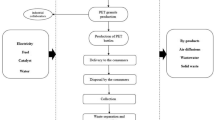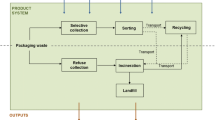Abstract
Purpose
Approximately 46,000 t/day of packaging waste was generated in China in 2010, of which, 2,500 t was composite packaging waste. Due to the lack of recycling technology and an imperfect recovery system, most of this waste is processed in sanitary landfills. An effective packaging waste management system is needed since this waste not only uses up valuable resources, but also increases environmental pollution. The purpose of this study is to estimate the environmental impact of the treatment scenarios in composite packaging waste which are commonly used in China, to determine the optimum composite packaging waste management strategy, and to design new separating and recycling technology for composite packaging, based on the life cycle assessment (LCA) results.
Methods
To identify the best treatment for composite packaging waste, the LCA software SimaPro 7.1.6 was used to assist in the analysis of the environmental impacts, coupled with the impact assessment method Eco-Indicator 99. LCA for composite packaging waste management was carried out by estimating the environmental impacts of the four scenarios most often used in China: landfill, incineration, paper recycling, and separation of polyethylene and aluminum. One ton of post-consumption Tetra Pak waste was selected as the functional unit. The data on the mass, energy fluxes, and environmental emissions were obtained from literature and site investigations.
Results and discussion
Landfill—scenario 1—was the worst waste management option. Paper recycling—scenario 3—was more environmentally friendly than incineration, scenario 2. Scenario 4, separating out polyethylene and aluminum, was established based on the LCA result, and inventory data were obtained from the demonstration project built by this research. In scenario 4, the demonstration project for the separation of polyethylene and aluminum was built based on the optimum conditions from single-factor and orthogonal experiments. Adding this flow process into the life cycle of composite packaging waste treatment decreased the environmental impacts significantly.
Conclusions
The research results can provide useful scientific information for policymakers in China to make decisions regarding composite packaging waste. Incineration could reduce more environmental impacts in the respiratory inorganics category, and separation of polyethylene and aluminum, in the fossil fuel category. If energy saving is the primary governmental goal, the separation of polyethylene and aluminum would be the better choice, while incineration would be the better choice for emission reduction.



Similar content being viewed by others
References
Almeida CMVB, Rodrigues AJM, Bonilla SH, Giannetti BF (2010) Emergy as a tool for Ecodesign: evaluating materials selection for beverage packages in Brazil. J Clean Prod 18(1):32–43
Banar M, Cokaygil Z, Ozkan A (2009) Life cycle assessment of solid waste management options for Eskisehir, Turkey. Waste Manage 29(1):54–62
Boer JD, Boer ED, Jager J (2007) LCA-IWM: a decision support tool for sustainability assessment of waste management systems. Waste Manage 27(8):1032–1045
Di XH, Nie ZR, Zuo TY (2005) Life cycle emission inventories for the fuels consumed by thermal power in China. China Environ Sci 25(5):632–635 (in Chinese)
Diaz R, Warith M (2006) Life-cycle assessment of municipal solid wastes: development of the WASTED model. Waste Manage 26(8):886–901
Ekvall T, Assefa G, Björklund A, Eriksson O, Finnveden G (2007) What life-cycle assessment does and does not do in assessments of waste management. Waste Manage 27(8):989–996
General Administration of Quality Supervision, Inspection and Quarantine of the People's Republic of China, Standardization Administration of the People's Republic of China (2009) Requirements of restricting excessive package—foods and cosmetics (GB 23350-2009)
Hong RJ, Wang GF, Guo RZ, Cheng X, Liu Q, Zhang PJ (2006) Life cycle assessment of BMT based integrated municipal solid waste management: case study in Pudong, China. Resour Conserv Recy 49(2):129–146
Hong JL, Li XZ, Cui ZJ (2010) Life cycle assessment of four municipal solid waste management scenarios in China. Waste Manage 30(11):2362–2369
International Standardisation Organisation (2006) ISO 14044: 2006 environmental management–life cycle assessment–requirements and guidelines. ISO Central Secretariat, Geneva
Jin YN, Zhou BY, Ding MY, Li L (2008) Analysis of the generation and recycling of packaging waste in China. Res Environ Sci 21(6):90–94 (in Chinese)
Khoo HH (2009) Life cycle impact assessment of various waste conversion technologies. Waste Manage 29(6):1892–1900
Kirkeby JT, Birgisdottir H, Bhander GS, Hauschild M, Christensen TH (2007) Modelling of environmental impacts of solid waste landfilling within the life-cycle analysis program EASEWASTE. Waste Manage 27(7):961–970
Liu YH, Liu T, Sha GY, Peng X (2008) Life cycle inventory model of cargo transportation. J Anhui Univ Technol (Natural Science) 25(2):205–207 (in Chinese)
Liu XL, Wang HT, Chen J, He Q, Zhang H, Jiang R, Chen XX, Hou P (2010) Method and basic model for development of Chinese reference life cycle database. Acta Sci Circumstantiae 30(10):2136–2144 (in Chinese)
Ma LP, Wang ZH, Gong XZ, Nie ZR (2006) Life cycle inventory analysis of two types of freight transport on city roads. The new progress on material sciences and engineering. pp. 12–16 (in Chinese)
Madival S, Auras R, Singh SP, Narayan R (2009) Assessment of the environmental profile of PLA, PET and PS clamshell containers using LCA methodology. J Clean Prod 17(13):1183–1194
Mendes MR, Aramaki T, Hanaki K (2004) Comparison of the environmental impact of incineration and landfilling in São Paulo city as determined by LCA. Resour Conserv Recy 41(1):47–63
Merrild H, Damgaard A, Christensen TH (2008) Life cycle assessment of waste paper management: the importance of technology data and system boundaries in assessing recycling and incineration. Resour Conserv Recy 52(12):1391–1398
Morrow H (2010) Cadmium and cadmium alloys. Kirk-Othmer encyclopedia of chemical technology. Wiley, New York
Mourad AL, Garcia EEC, Vilela GB, Zuben FV (2008) Environmental effects from a recycling rate increase of cardboard of aseptic packaging system for milk using life cycle approach. Int J Life Cycle Assess 13(2):140–146
Peters GM, Rowley HV (2009) Environmental comparison of biosolids management systems using life cycle assessment. Environ Sci Technol 43(8):2674–2679
PRe Consultants (2007) The Eco-indicator 99: a damage oriented method for life cycle impact assessment manual for designers. Netherlands: Amersfoort
Ross S, Evans D (2003) The environmental effect of reusing and recycling a plastic-based packaging system. J Clean Prod 11(5):561–571
Schmidt JH, Holm P, Merrild A, Christensen P (2007) Life cycle assessment of the waste hierarchy—a Danish case study on waste paper. Waste Manage 27(11):1519–1530
Villanueva A, Wenzel H (2007) Paper waste-recycling, incineration or landfilling? A review of existing life cycle assessments. Waste Manage 27(8):529–546
Wang XW, Hua B (2006) Global scope assessment: a novel method and its application to the Chinese paper industry. Energ Policy 35(3):1610–1615
Winkler J, Bilitewski B (2007) Comparative evaluation of life cycle assessment models for solid waste management. Waste Manage 27(8):1021–1031
Xie MH, Li L, Qiao Q, Sun QH (2011) A comparative study on milk packaging using life cycle assessment—from PA-PE-Al laminate and polyethylene in China. J Clean Prod 19(17–18):2100–2106
Yuan BR, Nie ZR, Di XH (2006) Life cycle inventories of fossil fuels in China (II): final life cycle inventories. Mod Chem Ind 26(4):59–61 (in Chinese)
Zabaniotou A, Kassidi E (2003) Life cycle assessment applied to egg packaging made from polystyrene and recycled paper. J Clean Prod 11(5):549–559
Zhao W, Voet E, Zhang YF, Huppes G (2009a) Life cycle assessment of municipal solid waste management with regard to greenhouse gas emissions: case study of Tianjin, China. Sci Total Environ 407(5):1517–1526
Zhao Y, Wang HT, Lu WJ, Damgaard A, Christensen TH (2009b) Life-cycle assessment of the municipal solid waste management system in Hangzhou, China. Waste Manage Res 27(4):399–406
Zhou BY, Guo LL, Li L, Yu HJ (2010) Characteristics of generation and recycling of plastic packaging waste in China and management countermeasures. Res Environ Sci 23(3):282–287 (in Chinese)
Zuben FV (2006) Recycling polyethylene and aluminium from aseptic packaging via plasma process. Annals of IV global conference on sustainable product development and life cycle engineering-sustainable manufacturing, RR14
Acknowledgments
The authors would like to thank the Chinese Research Academy of Environmental Sciences for carrying out this assessment and also to thank the reviewers for their comments. The work was funded by the Critical Patented Projects in the Control and Management of the National Polluted Water Bodies in China (no. 2008ZX07208-002-001) and the Chinese National Public Interest Environmental Protection Research Fund (no. HBGY2009467080).
Author information
Authors and Affiliations
Corresponding authors
Additional information
Responsible editor: Hans-Jürgen Garvens
Rights and permissions
About this article
Cite this article
Xie, M., Qiao, Q., Sun, Q. et al. Life cycle assessment of composite packaging waste management—a Chinese case study on aseptic packaging. Int J Life Cycle Assess 18, 626–635 (2013). https://doi.org/10.1007/s11367-012-0516-6
Received:
Accepted:
Published:
Issue Date:
DOI: https://doi.org/10.1007/s11367-012-0516-6




